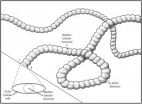(Press-News.org) CAMBRIDGE, Mass. (May 9, 2014) – Whitehead Institute scientists have identified a genetic cause of a facial disorder known as hemifacial microsomia (HFM). The researchers find that duplication of the gene OTX2 induces HFM, the second-most common facial anomaly after cleft lip and palate.
HFM affects approximately one in 3,500 births. While some cases appear to run in families, no gene had been found to be causative. That is until Whitehead Fellow Yaniv Erlich and his lab set out to do just that. Their work is described in this week's issue of the journal PLOS ONE.
Patients with HFM tend to have asymmetrical faces, --typically with one side of the upper and lower jaws smaller than the opposite side--a smaller or malformed ear on the affected side, and, in some cases, neurological or developmental abnormalities.
Thought to be brought on by circulation difficulties during embryonic development, HFM is also thought to be sporadic—meaning that it occurs spontaneously rather than through inheritance. However, one family in northern Israel has more than its share of the anomaly.
To identify the origin of this family's disorder, Erlich and lab technician Dina Zielinski began studying the genomes of a five-year-old female member of the family, along with those of her mother, grandmother, and male cousin, who all exhibited traits of HFM. Later, the genetic information from the grandmother's Russian cousin, who resides in the Philadelphia area, was recruited to the study.
"What's unique here is that this is the largest family with this disorder described in the literature," says Erlich. "Most of the time, you see one person affected, or perhaps two people—a parent and a child. Such a large family increases the power of the genetic study and clearly signals that there is a genetic component to a disease."
To find the cause of this family's HFM, Zielinski began by searching for a point mutation, but the five of the study participants held no such mutation in common. Next she looked for sections of the genome that are duplicated. All had an extra copy of one 1.3 megabase pair section of chromosome 14. Duplications this large are frequently detrimental.
Within this large piece of DNA, Zielinski identified eight candidate genes that could cause the type of HFM running in this family. She then used two algorithms to compare the molecular signatures of these eight genes to other genes known to be responsible for various facial malformations with features similar to HFM. After this analysis, the gene OTX2 that codes for a transcription factor rose above the seven other candidates.
These results are supported by what is known of OTX2's function. Previous data indicates that the gene codes for a protein that is expressed in the heads and pharyngeal arches of mouse embryos in developmental stages corresponding to the periods when HFM abnormalities are thought to arise in humans.
Although this is a tantalizing hint as to OTX2's activity during development, Zielinski cautions that little is known about its overall role, in part because it serves as a transcription factor that regulates other genes.
"OTX2's activity is very complicated," says Zielinski, who is first author of the PLOS ONE paper. "Development is dependent on tight control of these transcription factors that turn other genes on and off. The feedback between OTX2 and other transcription factors is complex but we know that OTX2 plays a critical role in craniofacial patterning."
Intriguingly, another, darker role of OTX2 was highlighted during the course of the study. The little girl who was this research's main focus was diagnosed with medulloblastoma, a highly malignant tumor originating at the base of the brain in or near the cerebellum.
OTX2 is a known oncogene for her subclass of medulloblastoma, confirming that her OTX2 expression is out of line.
"OTX2 is one of the most common genes that is amplified in medulloblastoma," says Erlich. "So first you have this gene that is involved in facial development, and then the same gene is involved in some cases of medulloblastoma. It suggests a very interesting link between the two."
Despite the dim prognosis normally associated with this cancer, the girl has gone through treatment and is currently in remission.
Although an extra copy of OTX2 causes HFM in this family, it is not the only faulty gene responsible for this disorder. Zielinski looked at seven other familial cases of HFM and none had duplication of OTX2, opening up the possibility that there could be several other errant genes involved in familial HFM.
INFORMATION:
This work is supported by the Andria and Paul Heafy Family Fellowship, the Burroughs Wellcome Fund, Cathy and Jim Stone, and Ron Casty.
Written by Nicole Giese Rura
Yaniv Erlich is the Andria and Paul Heafy Fellow of Whitehead Institute for Biomedical Research, where his laboratory is located and all his research is conducted.
Full Citation:
"OTX2 duplication is implicated in hemifacial microsomia"
PLOS ONE, May 9, 2014.
Dina Zielinski (1), Barak Markus (1), Mona Sheikh (1), Melissa Gymrek (1,2,3,4), Clement Chu (5), Marta Zaks (6), Balaji Srinivasan (5), Jodi D. Hoffman (7), Dror Aizenbud (6,+), Yaniv Erlich (1,+).
1.Whitehead Institute for Biomedical Research, Cambridge, MA, USA
2. Harvard-MIT Division of Health Sciences and Technology, MIT, Cambridge, MA, USA
3. Program in Medical and Population Genetics, Broad Institute of MIT and Harvard, Cambridge, MA, USA
4. Department of Molecular Biology and Diabetes Unit, Massachusetts General Hospital, Boston, MA, USA
5. Counsyl, South San Francisco, CA, USA
6. Rambam Health Care Campus, Haifa, Israel
7. Division of Genetics, Tufts Medical Center, Boston, MA, USA
+ Equal contribution
Scientists find gene behind a highly prevalent facial anomaly
2014-05-10
ELSE PRESS RELEASES FROM THIS DATE:
Cardiac screening test may help determine who should take aspirin to prevent heart attack
2014-05-09
MINNEAPOLIS, MN – May 6, 2014 – For over 30 years, aspirin has been known to prevent heart attacks and strokes, but who exactly should take a daily aspirin remains unclear. New research published today in Circulation: Cardiovascular Quality and Outcomes shows that your coronary artery calcium (CAC) score, a measurement of plaque in the arteries that feed the heart, may help determine whether or not you are a good candidate for aspirin.
"Many heart attacks and strokes occur in individuals who do not appear to be at high risk," states lead author, Michael D Miedema, MD, ...
NASA's TRMM Satellite see spring storms hit the US Great Plains
2014-05-09
VIDEO:
The TRMM satellite flew above tornado spawning thunderstorms in the southern United States on May 9, 2014 at 0115 UTC. This simulated 3-D TRMM animation shows the location of intense...
Click here for more information.
The Tropical Rainfall Measuring Mission or TRMM satellite captured rainfall and cloud height information about the powerful thunderstorms and severe weather that affected the Great Plains over May 8 and 9.
Severe weather extended from Minnesota to southern ...
Plugging leaky blood vessels to save vision
2014-05-09
TORONTO – A new drug approach has been developed for safer clean-up of deformed blood vessels in the eye by a research team at the Lunenfeld-Tanenbaum Research Institute, Mount Sinai Hospital in Toronto.
The growth of malformed blood vessels that can burst is a leading cause of vision loss in North America. Retinopathy and retina degeneration are associated with premature birth, with diabetes, and with increasing age.
Research just published by Dr. Andras Nagy and co-authors shows both safety and effectiveness in their bioengineered compound when treating retinopathy ...
Paleontologists discover new fossil organism
2014-05-09
RIVERSIDE, Calif. — Scientists at the University of California, Riverside have discovered a fossil of a newly discovered organism from the "Ediacara Biota" — a group of organisms that occurred in the Ediacaran period of geologic time.
Named Plexus ricei and resembling a curving tube, the organism resided on the Ediacaran seafloor. Plexus ricei individuals ranged in size from 5 to 80 centimeters long and 5 to 20 millimeters wide. Along with the rest of the Ediacara Biota, it evolved around 575 million years ago and disappeared from the fossil record around 540 million ...
Discovery links rare, childhood neurodegenerative diseases to common problem in DNA repair
2014-05-09
(MEMPHIS, Tenn. – May 9, 2014) St. Jude Children's Research Hospital scientists studying two rare, inherited childhood neurodegenerative disorders have identified a new, possibly common source of DNA damage that may play a role in other neurodegenerative diseases, cancer and aging. The findings appear in the current issue of the scientific journal Nature Neuroscience.
Researchers showed for the first time that an enzyme required for normal DNA functioning causes DNA damage in the developing brain. DNA is the molecule found in nearly every cell that carries the instructions ...
Longevity gene may boost brain power
2014-05-09
Scientists showed that people who have a variant of a longevity gene, called KLOTHO, have improved brain skills such as thinking, learning and memory regardless of their age, sex, or whether they have a genetic risk factor for Alzheimer's disease. Increasing KLOTHO gene levels in mice made them smarter, possibly by increasing the strength of connections between nerve cells in the brain. The study was partly funded by the National Institutes of Health.
"This could be a major step toward helping millions around the world who are suffering from Alzheimer's disease and ...
Autism-related protein shown to play vital role in addiction
2014-05-09
BELMONT - In a paper published in the latest issue of the neuroscience journal Neuron, McLean Hospital investigators report that a gene essential for normal brain development, and previously linked to Autism Spectrum Disorders, also plays a critical role in addiction-related behaviors.
"In our lab, we investigate the brain mechanisms behind drug addiction – a common and devastating disease with limited treatment options," explained Christopher Cowan, PhD, director of the Integrated Neurobiology Laboratory at McLean and an associate professor of Psychiatry at Harvard Medical ...
Quick test can help spot depressed teenagers, UT Arlington nursing researcher finds
2014-05-09
A few minutes spent filling out a widely accepted mental health assessment in a health care provider's waiting room could make a big difference for some teenagers suffering from depression, according to new study from a nursing researcher at The University of Texas at Arlington.
Sharolyn Dihigo, a nurse practitioner and clinical assistant professor in the UT Arlington College of Nursing, recently examined available research to determine whether nurse practitioners and others in primary care settings should add a mental health screening to well visits for teenage patients. ...
Conducting polymer films decorated with biomolecules for cell research use
2014-05-09
The ability to create conducting polymer films in a variety of shapes, thicknesses and surface properties rapidly and inexpensively will make growing and testing cells easier and more flexible, according to a team of Penn State bioengineers.
"The ultimate goal of this collaborative project is to be able to create a substrate for growth and manipulation of cells," said Sheereen Majd, assistant professor of bioengineering. "Cells on a surface need to recognize biomolecules like extracellular matrix proteins to be able to adhere and grow. We ultimately would like to be able ...
Grape consumption may offer benefits for symptomatic knee osteoarthritis
2014-05-09
Fresno, CA – New research presented last week at the Experimental Biology conference in San Diego, California, suggests that regular grape consumption may help alleviate pain associated with symptomatic osteoarthritis of the knee, and improve joint flexibility and overall mobility. Researchers attribute these potential benefits to the polyphenols found in grapes.
The sixteen week clinical study, undertaken by Texas Woman's University, was designed to investigate the benefits of grape consumption on inflammation and osteoarthritis outcomes. 72 men and women with knee ...



